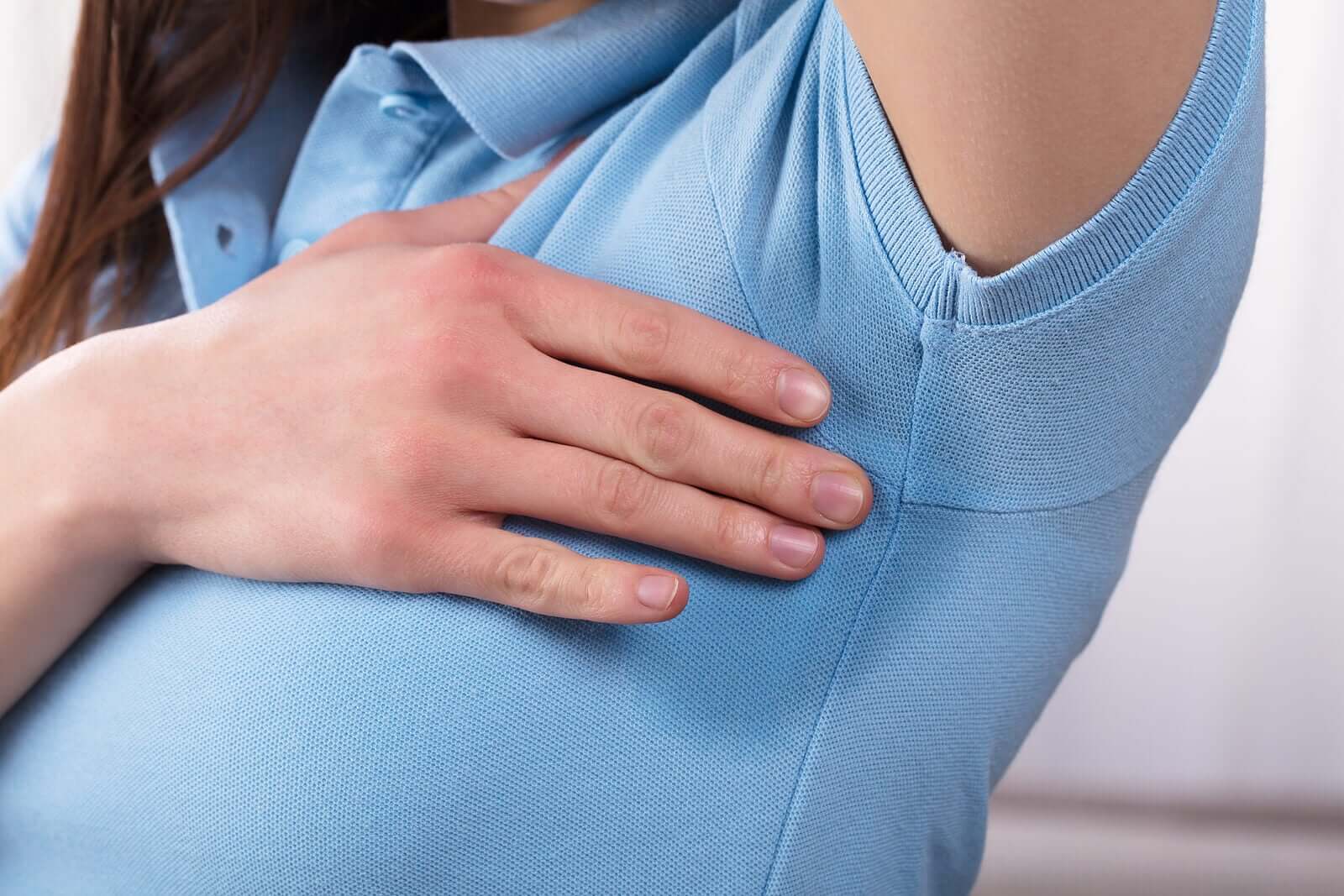Sweat and Body Odor in Adolescence: What You Need to Know


Written and verified by the dermatologist Maria del Carmen Hernandez
Sweat and body odor are two important players in the physical changes of adolescence. In fact, they’re usually a very frequent reason for consultation because they manage to affect self-esteem and even interfere with family life.
We’ll tell you why these changes occur in your body and what measures you should take to prevent them. Do not miss it!
What is sweat?
Sweat is a watery mixture of very complex chemicals. It consists mainly of water, sodium chloride (salt), and various elements in varying concentrations. Among them, vitamin K and some enzymes or peptides.
The purpose of this secretion is to regulate temperature and protect the skin barrier. Therefore, its production is part of a physiological, natural, and essential process for health.
The sweat-producing glands
There are two main types of sweat glands, which are responsible for the production of sweat:
- Eccrine sweat glands: These are the most numerous, are distributed throughout most of the body and produce the greatest amount of sweat. They tend to focus on the hands, feet, face, and back.
- Apocrine sweat glands: These play a minor role in the overall production of sweat, as they’re limited to specific regions of the body, such as the armpits, areolas, and the external genital area.
In addition to sweat, our skin contains other types of glands (called sebaceous glands) that secrete a more viscous and greasy liquid. This product accumulates on the surface of the skin and can modify the composition of sweat. In general, these glands are located close to the hair follicles, at the level of the scalp, the face, and the anogenital area.

Changes in sweat and body odor during adolescence
When puberty begins, hormonal changes occur throughout the body, which also affect the sweat and sebaceous glands of the skin.
The hormones of this stage modify the skin’s pH and this generates an increase in the usual bacterial flora, which is responsible for the decomposition of sweat and the modification of its smell. Therefore, the increase in the number of bacteria on the skin results in an increased unpleasant body odor, characteristic of this stage.
For their part, the pubertal hormones also stimulate eccrine glands, which increase sweat production throughout the body. This explains why teens perspire much more than children.
Bromhidrosis
This is a common pathology, which significantly affects the quality of life of those who suffer from it. Its main characteristic is the presence of smelly sweat all over the body.
In general, it can be treated or prevented with certain changes in hygiene habits, but there are also medical treatments.
It’s important to consult a specialist in the event of noticeable changes in odor, as they may be related to certain diseases, such as diabetes, kidney disease, and liver problems.
Read also: 5 Ways to Boost Confidence and Avoid Anxiety in Teens
Recommendations to avoid sweat and body odor in adolescence
Pubertal hormonal changes are inevitable, but you can implement certain hygienic measures to improve your quality of life. For example, a gentle cleaning routine with neutral products that are free of aggressive agents or sulfates is highly recommended.
Here are some tips to improve the appearance of your skin:
- Increase the frequency of rinsing your skin to combat excess sweat.
- Always choose pH neutral hygiene products, such as antibacterial gels.
- Choose the deodorant that best meets the needs of your body: Conventional deodorants fight bacteria that generate bad odors, while antiperspirants reduce the production of sweat and moisture.
- Try waxing to reduce sweating and odor in certain areas, like the armpits.
- Change clothes several times a day and wash them properly.
- Avoid footwear made of synthetic materials to improve foot odor.

About the physical changes of adolescence
Adolescence involves a huge amount of physical and mental changes, which you must accompany in the best possible way.
In general, the changes in the skin are mild and transient, and both hyperhidrosis and bromhidrosis aren’t frequent at this stage.
However, minimal changes can have a huge impact on young people and it’s important to offer the necessary care guidelines so that this doesn’t affect their emotions or social relationships.
Sweat and body odor are two important players in the physical changes of adolescence. In fact, they’re usually a very frequent reason for consultation because they manage to affect self-esteem and even interfere with family life.
We’ll tell you why these changes occur in your body and what measures you should take to prevent them. Do not miss it!
What is sweat?
Sweat is a watery mixture of very complex chemicals. It consists mainly of water, sodium chloride (salt), and various elements in varying concentrations. Among them, vitamin K and some enzymes or peptides.
The purpose of this secretion is to regulate temperature and protect the skin barrier. Therefore, its production is part of a physiological, natural, and essential process for health.
The sweat-producing glands
There are two main types of sweat glands, which are responsible for the production of sweat:
- Eccrine sweat glands: These are the most numerous, are distributed throughout most of the body and produce the greatest amount of sweat. They tend to focus on the hands, feet, face, and back.
- Apocrine sweat glands: These play a minor role in the overall production of sweat, as they’re limited to specific regions of the body, such as the armpits, areolas, and the external genital area.
In addition to sweat, our skin contains other types of glands (called sebaceous glands) that secrete a more viscous and greasy liquid. This product accumulates on the surface of the skin and can modify the composition of sweat. In general, these glands are located close to the hair follicles, at the level of the scalp, the face, and the anogenital area.

Changes in sweat and body odor during adolescence
When puberty begins, hormonal changes occur throughout the body, which also affect the sweat and sebaceous glands of the skin.
The hormones of this stage modify the skin’s pH and this generates an increase in the usual bacterial flora, which is responsible for the decomposition of sweat and the modification of its smell. Therefore, the increase in the number of bacteria on the skin results in an increased unpleasant body odor, characteristic of this stage.
For their part, the pubertal hormones also stimulate eccrine glands, which increase sweat production throughout the body. This explains why teens perspire much more than children.
Bromhidrosis
This is a common pathology, which significantly affects the quality of life of those who suffer from it. Its main characteristic is the presence of smelly sweat all over the body.
In general, it can be treated or prevented with certain changes in hygiene habits, but there are also medical treatments.
It’s important to consult a specialist in the event of noticeable changes in odor, as they may be related to certain diseases, such as diabetes, kidney disease, and liver problems.
Read also: 5 Ways to Boost Confidence and Avoid Anxiety in Teens
Recommendations to avoid sweat and body odor in adolescence
Pubertal hormonal changes are inevitable, but you can implement certain hygienic measures to improve your quality of life. For example, a gentle cleaning routine with neutral products that are free of aggressive agents or sulfates is highly recommended.
Here are some tips to improve the appearance of your skin:
- Increase the frequency of rinsing your skin to combat excess sweat.
- Always choose pH neutral hygiene products, such as antibacterial gels.
- Choose the deodorant that best meets the needs of your body: Conventional deodorants fight bacteria that generate bad odors, while antiperspirants reduce the production of sweat and moisture.
- Try waxing to reduce sweating and odor in certain areas, like the armpits.
- Change clothes several times a day and wash them properly.
- Avoid footwear made of synthetic materials to improve foot odor.

About the physical changes of adolescence
Adolescence involves a huge amount of physical and mental changes, which you must accompany in the best possible way.
In general, the changes in the skin are mild and transient, and both hyperhidrosis and bromhidrosis aren’t frequent at this stage.
However, minimal changes can have a huge impact on young people and it’s important to offer the necessary care guidelines so that this doesn’t affect their emotions or social relationships.
All cited sources were thoroughly reviewed by our team to ensure their quality, reliability, currency, and validity. The bibliography of this article was considered reliable and of academic or scientific accuracy.
- Lam TH, Verzotto D, Brahma P, Ng AHQ, Hu P, Schnell D, Tiesman J, Kong R, Ton TMU, Li J, Ong M, Lu Y, Swaile D, Liu P, Liu J, Nagarajan N. Understanding the microbial basis of body odor in pre-pubescent children and teenagers. Microbiome. 2018 Nov 29;6(1):213. doi: 10.1186/s40168-018-0588-z. PMID: 30497517; PMCID: PMC6267001. Disponible en: https://europepmc.org/article/pmc/pmc6267001
- Gerrett N, Griggs K, Redortier B, Voelcker T, Kondo N, Havenith G. Sweat from gland to skin surface: production, transport, and skin absorption. J Appl Physiol (1985). 2018 Aug 1;125(2):459-469. doi: 10.1152/japplphysiol.00872.2017. Epub 2018 May 10. PMID: 29745799. Disponible en: https://pubmed.ncbi.nlm.nih.gov/29745799/
- Perera E, Sinclair R. Hyperhidrosis and bromhidrosis — a guide to assessment and management. Aust Fam Physician. 2013 May;42(5):266-9. PMID: 23781522. Disponible en: https://pubmed.ncbi.nlm.nih.gov/23781522/
- Semkova K, Gergovska M, Kazandjieva J, Tsankov N. Hyperhidrosis, bromhidrosis, and chromhidrosis: Fold (intertriginous) dermatoses. Clin Dermatol. 2015 Jul-Aug;33(4):483-91. doi: 10.1016/j.clindermatol.2015.04.013. Epub 2015 Apr 8. PMID: 26051066. Disponible en: https://pubmed.ncbi.nlm.nih.gov/26051066/
This text is provided for informational purposes only and does not replace consultation with a professional. If in doubt, consult your specialist.








